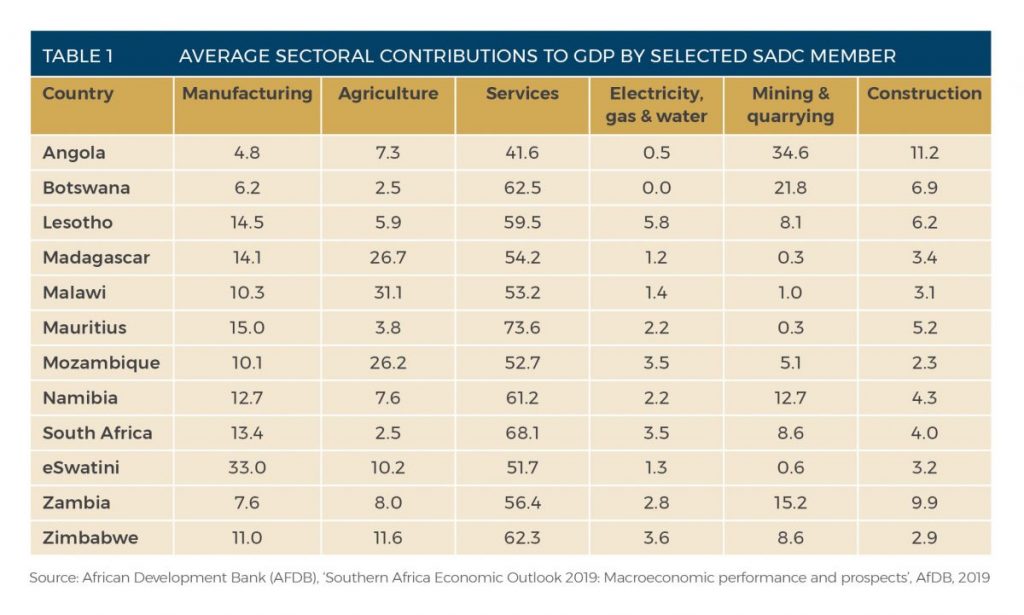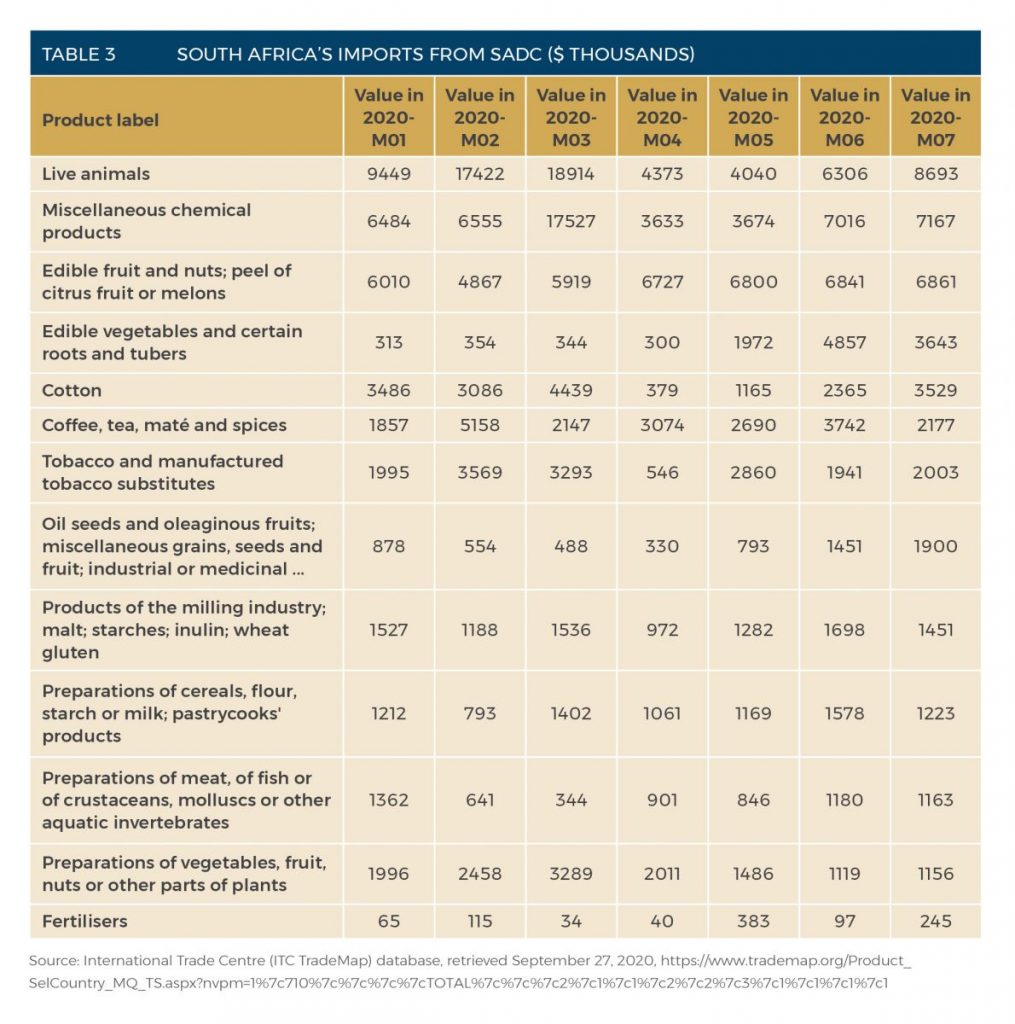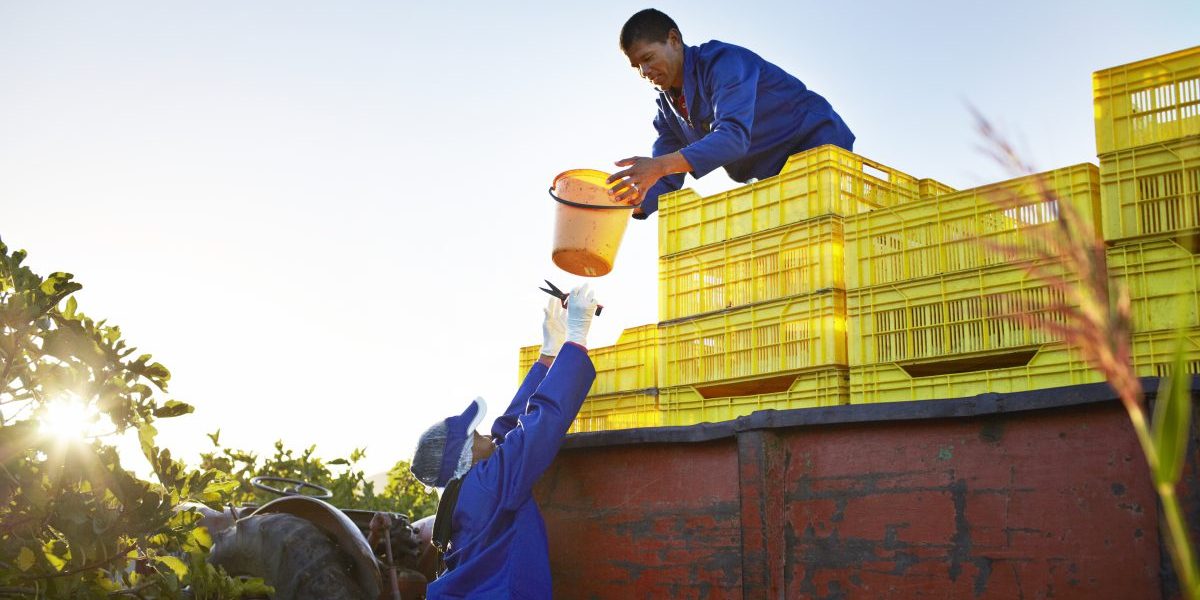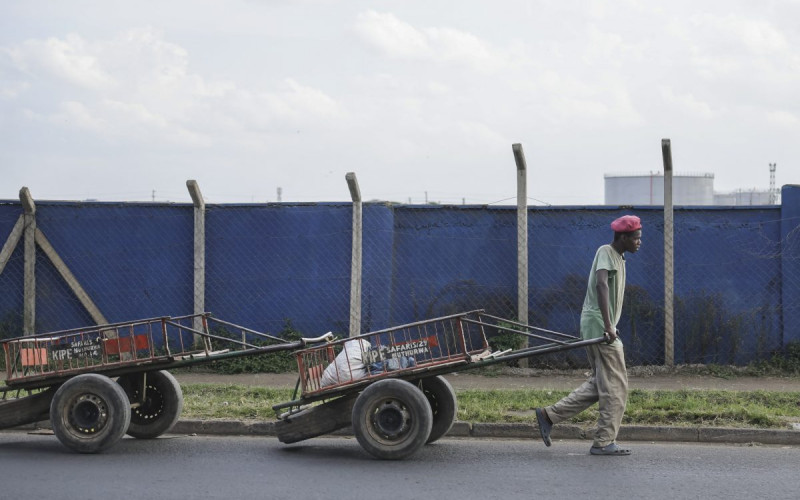Recommendations
- Agricultural value chains in the SADC region should be geared towards creating opportunities both for small-scale subsistence farming and large-scale, export-geared commercial farming, thus constituting a ‘dual approach’ to agricultural development in the region.
- Governments and the business sector should form public–private sector partnerships to develop resilient infrastructure for the agricultural sector, including the adoption of climate smart technologies.
- Various activities in SADC agro-value chains should be digitalised to ensure more effective interactions between farmers, input suppliers, transport and logistics service providers, financiers and other value chain partners.
- Priority should be given at government level to concluding outstanding issues relating to the implementation of the African Continental Free Trade Area (AfCFTA) which would then constitute the springboard for higher volumes of agricultural trade, thus improving trade revenues, food security and employment in the agricultural sector across the continent.
Executive summary
COVID-19 has affected global value chains (GVCs) by interrupting transport and logistics, supply and production dynamics, and demand and consumption patterns. These effects have also been felt in the Southern African Development Community (SADC) across agricultural value chains, impacting regional food security, intraregional trade and economic growth. Although agriculture has been less severely affected by COVID-19 than other sectors, the pandemic has nevertheless exposed challenges in SADC agro value chains and highlighted areas for improvement. This policy briefing explores these challenges and the impact of COVID-19, and how SADC can optimise agro-value chains in driving stronger regional integration and growth. Key challenges include a lack of heterogeneity in member countries’ agricultural activities, which hampers intraregional trade, a strong dependence on subsistence farming, which lacks commercial and export potential, and widespread food insecurity. Priorities going forward include enhancing food security in the SADC region, making more productive use of the small-scale farming sector and using the African Continental Free Trade Area as a lever for agricultural and regional development.
Introduction
COVID-19 has affected GVCs by interrupting activity in three areas: transport and logistics, supply and production dynamics, and demand and consumption patterns.1Xiaolan Fu, ‘Innovative technologies and post-Coronavirus economic recovery: A global value chains perspective,’ InternationalScience Council, June 2, 2020, https://council.science/current/news/innovative-technologies-and-post-coronavirus-economicrecoverya-global-value-chains-perspective/.These effects have also been felt in the SADC region across agricultural value chains, which comprise producers (farmers), suppliers (industries), distributors (transport and logistics) and consumers in the region. Agro-value chains are central to SADC food security systems, intra-regional integration, trade and cooperation, and economic growth.2Alexander Mutale, ‘Food insecurity threatens Sadc region,’ Financial Mail, October 10, 2019, https://www.businesslive.co.za/fm/features/africa/2019-10-10-food-insecurity-threatens-sadc-region/.
While the agricultural sector in the SADC region has been minimally affected by COVID-19, the pandemic has shed light on some of the challenges that SADC agro-value chains face and accentuated them
The disruption to export and import activity has effectively reduced trade flows and increased trade deficits
While the agricultural sector (in contrast to other sectors) in the SADC region has been minimally affected by COVID-19,3Wandile Sihlobo, ‘The effects of the Covid-19 pandemic on agricultural employment in South Africa,’ BizCommunity, June 23, 2020, https://www.bizcommunity.com/Article/196/358/205388.html.the pandemic has nevertheless shed light on some of the challenges that SADC agro-value chains face and also accentuated them. Job creation has declined significantly in the agricultural sector due to social distancing regulations.4Sihlobo, ‘The effects of the Covid-19 pandemic’.Furthermore, informal, small and medium-sized enterprises (SMEs) have had to contend with shifting demand patterns, interrupted sales channels and limited access to inputs and services.5Andrew Bowman and Reena Das Nair, ‘Covid-19 impacts on SME maize and dairy processors in South Africa’ (Project Brief, Innovation & Inclusion in Agro-processing, June 30, 2020), https://www.researchgate.net/publication/342716227_Covid-19_impacts_on_SME_maize_and_dairy_processors_in_South_Africa.South African SMEs were already struggling before the pandemic, with 80% of small business owners saying (in a 2019 survey) that they would need funding. By May 2020, it was estimated that SMEs would see their revenue decline by 60% during the pandemic.6Trevor Gosling, ‘COVID-19: How to Save South African SMEs,’ The South African, May 12, 2020, https://www.thesouthafrican.com/news/finance/covid-19-how-to-save-south-african-smes/.
The disruption to export and import activity has effectively reduced trade flows and increased trade deficits. For instance, the closure of borders reduced informal cross-border transactions, which account for 30–40% of intra-SADC trade.7Innocent Muranganwa, ‘Effects of the COVID-19 Measures on Trade Facilitation in SADC,’ Tralac, October 12, 2020, https://www.tralac .org/news/article/14951.The pandemic has highlighted the globalised nature of trade and the importance of the SADC region integrating into global value chains in order to improve countries’ development prospects.8Carlos Brito, ‘COVID-19 has intensified the digital divide,’ World Economic Forum, September 24, 2020, https://www.weforum.org/agenda/2020/09/covid-19-has-intensified-the-digital-divide/.However, the pandemic has also presented unique opportunities for ‘building back better’ and developing inclusive agro-value chains in the region.
This policy briefing explores the short- and long-term effects of COVID-19 on SADC agro-value chains, first depicting the state of agriculture in the region and then highlighting the challenges presented by the effects of the pandemic. It also discusses some of the opportunities available to policymakers to develop sustainable agro-value chains in the region.
Agriculture in SADC: Recent trends
Agriculture is a major economic activity for most SADC member countries. It provides employment, trade opportunities, food and income to around 70% of the region’s population and the performance of the sector is closely linked to economic development, food security and stability.9SADC, ‘Agriculture and Food Security’, https://www.sadc.int/themes/agriculture-food-security/.However, agriculture’s contribution to gross domestic product (GDP) varies widely across SADC member countries. In countries such as Botswana, South Africa, Mauritius and Zambia, agriculture’s share of GDP is less than 3%, whereas it is more than 26% in countries such as Madagascar, Mozambique and Malawi (Table 1).10The World Bank (WB World Development Indicators database), database, https://databank.worldbank.org/indicator/NY.GDP.MKTP.KD.ZG/1ff4a498/Popular-Indicators.

In 2018, the region was severely affected by the El Niño-induced drought.11Southern Times, ‘SADC member states must develop the agriculture sector,’ The Southern Times, November 3, 2019, https://southerntimesafrica.com/site/news/sadc-member-states-must-develop-the-agriculture-sector.However, SADC then set off on a recovery path with South Africa, for instance, expected to deliver its second-largest grain harvest in the 2019/2020 season.12Donwald Pressly, ‘High-end agri products most affected by COVID-19 lockdown,’ Farmers Weekly, July 30, 2020,https://www.farmersweekly.co.za/agri-news/south-africa/high-end-agri-products-most-affected-by-covid-19-lockdown/The regional average contribution of agriculture to GDP is around 13%.13SADC, ‘Agriculture and Food Security’.As such, agriculture, including agro-processing and agricultural value chains, has been earmarked as one of three potential growth areas, alongside ‘natural resource-led growth including minerals beneficiation and processing, also linking into value chains, both regional and global, and enhanced participation in domestic, regional and global value chains’,14SADC, ‘SADC Industrialisation Strategy and Roadmap 2015‒2063,’ April 29, 2015, https://library.buse.ac.zw/docs/gvt-publications/sadc-roadmap.pdf.under the SADC Industrialization Strategy and Roadmap 2015–2063. This roadmap places a specific focus on agro-processing and regional collaboration through the implementation of a comprehensive regional agricultural policy (RAP) and the development of an agricultural information management system (AIM) which is designed to improve coordination at both the national and regional levels. These initiatives highlight the importance of agriculturally geared economic activity to drive socioeconomic development.
Despite greater attention being given at the national and regional levels to developing the agricultural value chains across SADC member countries, the region faces some well-documented challenges in their pursuit of such an objective.
Agriculture, including agro-processing and agricultural value chains, has been earmarked as one of three potential growth areas, alongside ‘natural resource-led growth including minerals beneficiation and processing, also linking into value chains, both regional and global, and enhanced participation in domestic, regional and global value chains’
First, SADC economies tend to be at similar levels of agricultural development and produce similar products, such as grains (maize, wheat and sorghum), nuts and vegetables, among others – except for South Africa which also produces wine and citrus fruits.15Henri A. Minnaar, Theunis Duvenhage and Vickey de Villiers, Profiling of the Regional Agro-Processing Value Chains in the SADC Region, draft final report (Mauritius: Imani Development, March 6, 2019), https://agbiz.co.za/uploads/AgbizNews19/190322_SADC%20Agro-Processing%20Draft%20Final%20Report.pdf.
Second, the agricultural sector in Africa has been experiencing ‘sustained neglect’, which has effectively transformed the continent from a key exporter of agricultural products in the 1960s to a net importer today.16Ibrahim Mayaki, ‘3 ways to transform agriculture in Africa,’ World Economic Forum on Africa, May 11, 2016, https://www.weforum.org/agenda/2016/05/3-ways-to-transform-agriculture-in-africa/.
Third, half the total population of the SADC region is employed in the agricultural sector, but the region’s focus remains predominantly on subsistence farming, rather than on large-scale commercial production for export purposes.17SADC, ‘Agriculture and Food Security’.However, both subsistence farming and export-orientated farming are valuable in their own way: the former has
The agricultural sector in Africa has been experiencing ‘sustained neglect’, which has effectively transformed the continent from a key exporter of agricultural products in the 1960s to a net importer today
significant socioeconomic benefits and the latter contributes to economic development through export earnings. Therefore, neither should be neglected. In fact, it is important for SADC countries to take a dual approach to improving agro-value chains in the region – improving both subsistence farming and export-orientated production.
Fourth, there is growing uncertainty surrounding food production. Climate change has already complicated the issues of crop choice and optimal geographical locations for crop production.18Tamara Paremoer, ‘Regional Value Chains: Exploring Linkages and Opportunities in the Agro-processing Sector Across Five SADC Countries’ (Working Paper 4/2018, South African Institute of International Affairs, Johannesburg, 2019), https://saiia.org.za/saiiatoolkit/regional-value-chains-linkages-and-opportunities-in-agro-processing-across-five-sadc-countries/.For example, in 2018, the impact of the escalating climate crisis on southern Africa became clear when over 41 million people in 13 of the 16 SADC countries were estimated to be food insecure.19Mutale, ‘Food insecurity threatens Sadc’.Unfortunately, this is a continuing trend: in 2020 Zimbabwe experienced a 57% drop in maize production due to poor rainfall and the economic meltdown in the country, while eSwatini, Mozambique and Lesotho were among several countries affected by dry spells.20SADC Regional Vulnerability Assessment & Analysis Programme, Synthesis Report on the state of food and nutrition security and vulnerability in Southern Africa 2020 (Gaborone: SADC, July 29, 2020), https://www.tralac.org/news/article/14814-sadc-memberstates-urged-to-strengthen-mechanisms-to-mitigate-the-impact-of-covid-19-as-45-million-people-across-the-region-faceincreasing-food-insecurity.html.
There is growing uncertainty surrounding food production. Climate change has already complicated the issues of crop choice and optimal geographical locations for crop production
Even before COVID-19, agriculture and agro-value chains in Africa had been facing the challenges mentioned above.21Gillian Pais, Kartik Jayaram and Arend van Wamelen, ‘Safeguarding Africa’s food systems through and beyond the crisis,’ McKinsey & Company, June 5, 2020, https://www.mckinsey.com/featured-insights/middle-east-and-africa/safeguarding-africas-food-systems-through-and-beyond-the-crisis.The predominance of small-scale subsistence farming had already been putting pressure on governments and private-sector entities in the SADC region to create a more enabling environment for farmers to expand their operations.
The latter would include developing transport infrastructure to and from remote farming areas and incentivising agricultural suppliers and industries to move closer to these farms to afford them easier access to inputs. This is because boosting agricultural productivity is not enough to reduce poverty or develop SADC agro-value chains. Effective and efficient trade within the region as well as with other, international markets is also important.22SADC RVAA Synthesis Report 2020.Developing resilience in agricultural production and adopting climate-smart technologies are further keys to developing and maintaining SADC agro-value chains.
Effects of COVID-19 and associated lockdowns on SADC agro-value chains
SADC’s agro-value chains experienced relatively few disruptions from the COVID-19 pandemic because agriculture was generally declared an essential industry sector.23Department of Rural Development and Land Reform, ‘Minister Thoko Didiza: Food security declared an essential service during Coronavirus COVID-19,’ South African Government, March 26, 2020, https://www.gov.za/speeches/minister-thoko-didiza-food-security-declared-essential-service-during-coronavirus-covid-19This has helped maintain relatively resilient agro-value chains in the region as transport routes and ports have remained open. For example, notwithstanding the COVID-19 pandemic, Namibia has recorded a 42.7% growth rate in its agricultural sector.24News Service, ‘Agriculture sector records growth in Q1 amid COVID-19 pandemic,’ Namibia Economist, October 23, 2020, https://economist.com.na/56761/agriculture/agriculture-sector-records-growth-in-q1-amid-covid-19-pandemic/.Using available data from South Africa as a proxy for agricultural trade throughout SADC in 2020, a general trend was evident. Table 2 below shows South Africa’s exports to the SADC region from January to July 2020.
Table 2 shows that there was a drop in agricultural exports in the months of April and May 2020, which was around the time that lockdowns were being introduced by governments, but these drops were not significant and exports had recovered by around June. Similarly, Table 3 below shows that imports from the SADC region into South Africa have not been affected by the pandemic, specifically the closure of borders and national lockdown measures.


The real impact of COVID-19 has largely been in how it has exacerbated the (aforementioned) existing challenges25James Zhan et al., ‘Global value chain transformation to 2030: Overall direction and policy implications,’ VoxEU.org, August 13, 2020, https://voxeu.org/article/global-value-chain-transformation-decade-ahead.occurring in SADC agro-value chains ‒ evidenced in particular in the actions taken by governments to limit the impact of the pandemic. These are discussed below.
The real impact of COVID-19 has largely been in how it has exacerbated the existing challenges occurring in SADC agro-value chains
SADC agro-value chains: Opportunities amid the challenges
First, the most devastating socioeconomic consequence of COVID-19, as far as SADC agro-value chains are concerned, has been the difficulty faced by many in acquiring access to food, resulting in rising levels of hunger. The Synthesis Report on the state of food and nutrition security and vulnerability in Southern Africa 2020 showed that about 44.8 million people in southern Africa, living in both urban and rural areas, are food insecure. Data shows that food insecurity increased by about 10% between 2019 and 2020.26SADC RVAA, Synthesis Report 2020.In addition, the closure of schools due to COVID-19 has negatively affected food and nutrition security among children of school-going age, with an estimated 20.5 million schoolchildren not having access to meals and nutrition services normally provided by schools.27SADC RVAA, Synthesis Report 2020.
The Synthesis Report on the state of food and nutrition security and vulnerability in Southern Africa 2020 showed that about 44.8 million people in southern Africa, living in both urban and rural areas, are food insecure
Second, international agricultural production has increased. Similarly, SADC has recorded an 8% increase in maize production. However, the SADC region has seen disruptions in the transportation of agricultural produce, such as grain – prompted by COVID-19-related restrictions and border closures ‒ and its subsequent distribution to countries with food deficits.28SADC RVAA, Synthesis Report 2020
Third, the introduction of national lockdowns aimed at helping to mitigate the spread of COVID-19 has resulted in rising unemployment and the hardship that goes with it as the majority of people living in southern Africa ‘live hand to mouth’.29Deprose Muchena, ‘Southern Africa: Government intervention required as millions face hunger under COVID-19 lockdown regimes,’ Amnesty International, April 17, 2020, https://www.amnesty.org/en/latest/news/2020/04/southern-africa-governmentintervention-required-as-millions-face-hunger-under-covid19-lockdown-regimes/The implications for domestic markets and industries have been severe as travel restrictions have meant that some businesses, particularly SMEs and those in the informal sector, have had to lay off workers because they could not pay them, while other businesses have closed permanently. For instance, the shutting down of Beitbridge, the largest inland border in southern Africa between South Africa and Zimbabwe, curtailed intraregional trade and the movement of over 25,000 people per day.30Tendai Marima, ‘Southern Africa’s agricultural producers fear export losses from Covid-19,’ African Business, May 4, 2020, https://africanbusinessmagazine.com/region/southern-africa/southern-africas-agricultural-producers-fear-export-losses-fromcovid-19/.Based on earlier data (Tables 1‒3), the impact was particularly acute between April and May 2020.
Fourth, COVID-19 resulted in delays in the negotiation and implementation of the African Continental Free Trade Area (AfCFTA), which was to have taken off in mid-2020. The FTA eventually took effect in January 2021, although a number of countries still need to ratify the agreement in order to benefit from its tariff-free trade provision.31Africa Renewal, ‘AfCFTA: Africa readying for free trade come January 2021,’ The Zimbabwean, December 12, 2020, https://www.thezimbabwean.co/2020/12/afcfta-africa-readying-for-free-trade-come-january-2021/.The successful implementation of the AfCFTA has the potential to significantly strengthen regional integration efforts.32Abhishek Mishra, ‘Africa and COVID-19: Impact, Response, and Challenges to Recovery’ (ORF Occasional Paper No. 275, Observer Research Foundation, September 2020), https://www.orfonline.org/research/africa-and-covid19-impact-response-and-challengesto-recovery-74209/.It will also enable SADC agricultural value chains to offer protection to small-scale farmers, local markets and emerging industries through the elimination of tariffs on 90% of goods produced and a guarantee of free movement across the continent, which is vital for cooperation and consolidation of resources among member states.
The successful implementation of the AfCFTA has the potential to significantly strengthen regional integration efforts. It will also enable SADC agricultural value chains to offer protection to small-scale farmers, local markets and emerging industries
Fifth, the spread of COVID-19 has seen the heightened adoption of digital services across value chains globally. This has included a greater uptake of automation technologies, consumer-oriented platforms for food delivery, business-to-business e-commerce applications, and videoconferencing, among others.33Gerald C. Kane et al., ‘A case of acute disruption: Digital transformation through the lens of COVID-19,’ Deloitte.Insights, August 6, 2020, https://www2.deloitte.com/us/en/insights/topics/digital-transformation/digital-transformation-COVID-19.html.These services have had the effect of restructuring global value chain activities. SADC countries need to adapt to these changes, while also considering what is technically feasible in a regional context in view of the fact that technology utilisation varies in large-scale commercial farming and small-scale subsistence farming, respectively.34Mari-Lise du Preez, 4IR and water-smart agriculture in Southern Africa: A watch list of key technological advances (SAIIA Policy Insights No 91, South African Institute of International Affairs, Johannesburg, September 7, 2020), https://saiia.org.za/research/4irand-water-smart-agriculture-in-southern-africa-a-watch-list-of-key-technological-advances/With the adoption of technologies such as smartphone apps, videoconferencing and business e-commerce applications, there is great potential to extend agricultural value chain opportunities to smallholder farmers – those who have previously been precluded from participating in, and benefiting from, value chains.35Max Mattern and Rossana Ramirez, Digitizing Value Chain Finance for Smallholder Farmers (Focus Note No. 106, Consultative Group to Assist the Poor (CGAP), 2017), https://www.cgap.org/sites/default/files/Focus-Note-Digitizing-Value-Chain-FinanceApr-2017.pdf.
Conclusions and the way forward
SADC agricultural value chains face a number of challenges, chief among them being climate change, low levels of agricultural infrastructure development, poverty and food insecurity, the predominance of subsistence farming over export-oriented agriculture and, more recently, delays in the implementation of the AfCFTA. Although the agricultural sector in SADC has largely been spared the negative fallout from COVID-19 compared to other sectors, the latter has still exacerbated existing challenges facing the sector.
There are, however, opportunities for SADC to build more robust and inclusive agricultural value chains. Importantly, small-scale subsistence farming needs to be supported along with export-orientated commercial farming, with the help of appropriate interventions. There is also scope for SADC member governments and private businesses to form partnerships in developing resilient infrastructure, using climate-smart technologies that will take regional agriculture into the future and ensure that it is a sustainable driver of development. Another future-proofing technique would be to digitalise the SADC agro-value chains to improve communication between, and optimise the performance, of farmers, input suppliers, transport and logistics service providers, financiers and other value chain participants. The long-awaited AfCFTA, in turn, has the potential to be a catalyst for augmented agricultural production across the continent and to afford small farmers the opportunity to play a meaningful role in Africa’s agricultural development.
Acknowledgement
SAIIA gratefully acknowledges the support of SIDA for this publication.







